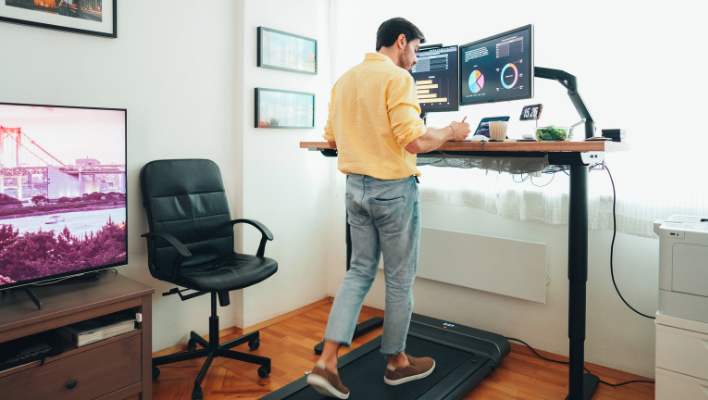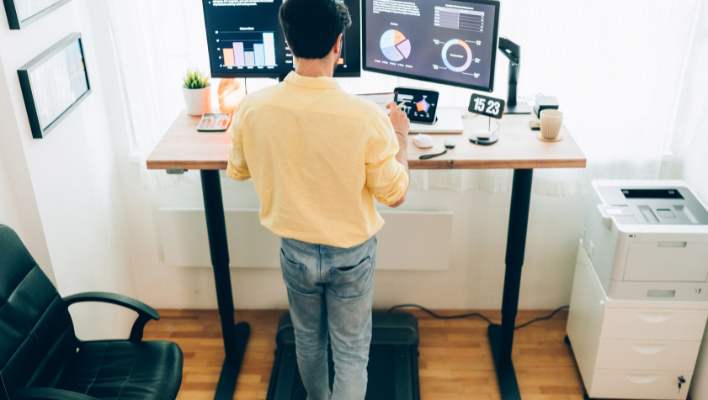Standing desks are beneficial for your back because they promote better posture and reduce the risk of developing musculoskeletal disorders. This article explores the advantages of standing desks in improving back health and provides tips on how to effectively use them for maximum benefits.
Sitting for prolonged periods has been linked to various health issues, including back pain. With the increasing popularity of remote work and sedentary lifestyles, more people are discovering the benefits of standing desks for their overall well-being. Standing desks offer an ergonomic solution that allows individuals to alternate between sitting and standing positions throughout the day, promoting better spinal alignment and reducing stress on the back muscles.
This can alleviate back pain, improve posture, and enhance overall physical health. We will delve into the advantages of standing desks for back health and explore tips on how to incorporate them into your workspace effectively. By the end, you’ll have a better understanding of how standing desks can improve your back health and overall productivity.
Table of Contents
The Impact Of Sitting On Your Spine
Standing desks can have a positive impact on your spine by reducing the prolonged sitting that can contribute to back pain and poor posture. By standing and moving regularly, you can alleviate strain on your back and promote better spinal health.
The Effects Of Prolonged Sitting On The Spine
Sitting for long periods of time has become a normal part of many people’s daily routines, whether it’s at work, while commuting, or during leisure activities. However, what most people overlook is the significant impact that prolonged sitting can have on their spine.
When you sit for extended periods, your spine is subjected to a static posture that can lead to a range of issues. Here, we will delve into the risks associated with a sedentary lifestyle and how sitting affects your posture and back muscles.
Read Also: Does a Standing Desk Help With Back Pain?
Understanding The Risks Of A Sedentary Lifestyle
Living a sedentary lifestyle puts you at an increased risk of developing various health problems, including those related to your spine. Studies have shown that excessive sitting can contribute to the development of chronic back pain, herniated discs, and even spinal degeneration.
Additionally, a sedentary lifestyle can also lead to weight gain, muscle imbalances, and decreased flexibility, all of which can further exacerbate back problems. It’s crucial to recognize the negative impact of a sedentary lifestyle on your overall spinal health.
How Sitting Affects Your Posture And Back Muscles
Sitting for long periods can have detrimental effects on your posture and the muscles that support your spine. When you sit for extended periods, your spine tends to adopt a slouched position, placing excessive pressure on the discs and vertebrae. This can lead to aches, stiffness, and even structural damage over time.
Moreover, sitting for extended periods can weaken the muscles that support your spine, including the abdominal and back muscles. These muscles are vital for maintaining proper posture and spinal alignment. When they become weakened or imbalanced, it can lead to poor posture, increased strain on the spine, and an increased risk of injuries.
To combat the negative effects of sitting, incorporating regular breaks to stretch and move around is essential. Additionally, considering the use of a standing desk can help promote a more upright posture and engage your muscles while you work or study.
The Rise Of Standing Desks
Over the years, there has been a growing trend in modern workplaces towards using standing desks. These innovative workstations are designed to provide an alternative to the traditional sitting desk, offering a multitude of benefits for both productivity and overall well-being. In this post, we will delve into the reasons behind the popularity of standing desks, explore the numerous benefits they offer, and discuss how they encourage movement and reduce sedentary behavior.
The Popularity Of Standing Desks In Modern Workplaces
Standing desks have gained immense popularity in modern workplaces, with more and more individuals recognizing the potential adverse effects of prolonged sitting. The sedentary nature of desk jobs can lead to an array of health issues, including back pain, poor posture, and reduced productivity. As a result, many companies and individuals are now on the lookout for ergonomic solutions that promote healthy and active work habits. Standing desks have emerged as a practical and effective solution, reshaping the workplace environment and revolutionizing the way we work.

Benefits Of Using A Standing Desk
Using a standing desk brings forth a host of benefits that can positively impact your overall well-being. Here are some key advantages:
- Improved posture: Sitting all day can strain your spinal column and lead to poor posture. Standing desks encourage an upright position, helping to alleviate back and neck pain, and maintaining a healthier posture throughout the workday.
- Increased energy and focus: Remaining seated for extended periods can lead to sluggishness and decreased productivity. Standing promotes blood circulation and oxygen flow, effectively boosting energy levels and mental clarity, ultimately enhancing focus and productivity.
- Reduced risk of obesity and chronic diseases: Studies have shown that excessive sitting is linked to a higher risk of obesity, heart disease, and diabetes. Utilizing a standing desk can help you burn more calories and maintain a healthier weight, reducing the risk of developing chronic diseases.
- Enhanced mood and well-being: Standing while working has been associated with enhanced mood and an overall sense of well-being. By promoting better blood flow and releasing mood-boosting endorphins, standing desks can contribute to a more positive and productive work environment.
How Standing Desks Promote Movement And Reduce Sedentary Behavior
One of the key advantages of standing desks is their ability to encourage movement and reduce sedentary behavior. By allowing you to easily transition between sitting and standing positions, standing desks promote more frequent changes in posture, which has numerous benefits including:
- Increased calorie burning: Standing burns more calories than sitting alone, helping to combat the negative effects of a sedentary lifestyle.
- Improved circulation: Regular movement from sitting to standing encourages blood flow throughout the body, reducing the risk of circulatory problems.
- Engagement of muscles: When standing, your muscles are engaged as they work to support your body weight, contributing to overall strength and toning.
- Reduced risk of musculoskeletal issues: Frequent postural changes and movement can reduce the likelihood of developing musculoskeletal problems associated with prolonged sitting.
By incorporating a standing desk into your workspace, you can actively combat the negative effects of sedentary behavior, promoting a healthier and more dynamic work environment.
Improving Posture And Spinal Alignment With Standing Desks

How Standing Desks Encourage Proper Posture
One of the key benefits of using a standing desk is its ability to encourage proper posture. Unlike traditional seated desks that often promote slouching and hunching over time, standing desks provide an ergonomic alternative that engages your core muscles and promotes a more upright position. By standing while working, you naturally align your spine, keeping it in a neutral position, which helps alleviate strain and pressure on your back.
The Role Of Standing Desks In Reducing Spinal Stress And Strain
Standing desks play a significant role in reducing stress and strain on your spine. When sitting for extended periods, your spinal discs can become compressed, leading to discomfort and potential long-term issues. By transitioning to a standing desk, you give your spine the opportunity to decompress and maintain proper alignment. This, in turn, can help alleviate tension and reduce the risk of developing conditions such as back pain, herniated discs, or even chronic posture-related problems.
Read Also: Can I Put My Desk Mat in the Washing Machine?
Tips For Maintaining Good Posture While Using A Standing Desk
To make the most of your standing desk and maintain good posture, here are a few helpful tips:
- Stand tall and avoid slumping. Keep your shoulders relaxed, your chest lifted, and your spine straight.
- Position your monitor at eye level to prevent hunching or straining your neck. Adjust the height of your desk or use a monitor riser if needed.
- Place a cushioned mat or an anti-fatigue mat under your feet to reduce discomfort and improve circulation.
- Avoid locking your knees or leaning on one leg while standing. Distribute your weight evenly on both feet to promote balance and stability.
| Do’s | Don’ts |
|---|---|
|
|
By following these guidelines and using a standing desk, you can improve your posture and spinal alignment, reducing the risk of back pain and other related issues. Remember, maintaining an active and ergonomic workspace is vital for your overall health and well-being.
Strengthening Back Muscles And Reducing Back Pain
Are you tired of dealing with back pain from sitting for long hours at your desk? Standing desks may just be the solution you’re looking for. Not only do they provide a change in posture, but they can also help strengthen your back muscles and alleviate back pain. In this article, we’ll explore the various ways standing desks can benefit your back health.
How Standing Desks Can Help Strengthen Back Muscles
One of the key advantages of using a standing desk is that it promotes better posture and helps engage your back muscles. When you stand, your core muscles automatically activate in order to maintain stability and balance. This engagement of the core muscles, including the back muscles, can help tone and strengthen these muscles over time. Additionally, standing encourages small movements and adjustments, which further engage the back muscles and prevent them from becoming stagnant or weak.
The Impact Of Standing On Core Strength And Stability
Having a strong and stable core is crucial for maintaining a healthy back. When you stand at a standing desk, you naturally engage your core muscles to support your body and maintain an upright position. This constant activation and strengthening of the core muscles can improve overall core strength and stability, leading to better back support and reduced strain on the spine. As a result, you may experience fewer instances of back pain and stiffness that often come from a weak core.
Read Also: How to Fix a Wobbly Desk
Studies On The Effectiveness Of Standing Desks In Reducing Back Pain
There have been several studies conducted to evaluate the effectiveness of standing desks in reducing back pain. These studies have shown promising results. In one study published in the Journal of Physical Therapy Science, researchers found that participants who used standing desks reported a significant reduction in lower back pain compared to those who sat for prolonged periods. This suggests that the use of standing desks can be an effective strategy for managing and preventing back pain.
Another study conducted by researchers at Texas A&M University showed that participants who used standing desks experienced less upper back and neck pain compared to those who used traditional seated desks. The study also noted that standing desks promoted better posture, which is crucial for reducing back pain.
| Study | Findings |
|---|---|
| Journal of Physical Therapy Science | Participants reported a significant reduction in lower back pain. |
| Texas A&M University study | Participants experienced less upper back and neck pain. |
While these studies provide evidence for the effectiveness of standing desks in reducing back pain, it’s important to note that individual experiences may vary. It’s advisable to consult with a healthcare professional or ergonomic specialist to determine the best approach for your specific needs.
- Standing desks can strengthen back muscles.
- The engagement of core muscles in standing improves stability.
- Studies show that standing desks can reduce back pain.
By incorporating a standing desk into your workspace, you can take a proactive step towards strengthening your back muscles and reducing back pain. Remember to start gradually and allow your body to adjust to the new posture. Whether you choose to stand for a few hours or alternate between standing and sitting, the benefits for your back health can be significant. Invest in your well-being and consider making the switch to a standing desk today!
Maximizing The Benefits Of A Standing Desk
Standing desks have gained popularity in recent years due to their potential benefits for posture, productivity, and overall well-being. However, to truly reap the rewards of using a standing desk, it is important to maximize its benefits. In this section, we will explore some key strategies to help you make the most of your standing desk experience.
Finding The Right Balance Between Sitting And Standing
While standing for extended periods can provide relief from prolonged sitting, it is crucial to strike a balance between sitting and standing throughout your workday. Moderation is key. Experts suggest alternating between sitting and standing every 30 minutes, giving your body time to adjust and preventing fatigue or discomfort.
Consider utilizing a timer or a smartphone app to remind yourself to switch between sitting and standing positions. By incorporating regular movement breaks, you can prevent excessive strain on your back and legs, promoting better circulation and reducing the risk of developing musculoskeletal issues.
Incorporating Movement And Stretching Exercises Into Your Work Routine
In addition to transitioning between sitting and standing, incorporating movement exercises into your work routine can further enhance the benefits of a standing desk. Simple exercises like stretching, walking, or performing light desk exercises can help alleviate muscle tension and promote flexibility.
- Neck rolls: Gently roll your neck from side to side, relieving tension in the neck and upper back.
- Shoulder shrugs: Lift your shoulders up towards your ears, hold for a few seconds, and then release. Repeat several times to release tension in the shoulders and upper back.
- Leg raises: While standing, lift one leg at a time, extending it straight out in front of you. Hold for a few seconds and then lower. Repeat with the other leg. This exercise can help improve circulation in the legs.
Regularly integrating these movements and stretches into your work routine can help prevent stiffness and promote a healthier body while using a standing desk.
Other Ergonomic Considerations For Using A Standing Desk
While standing desks are generally designed to be ergonomic, there are additional considerations to keep in mind to optimize your comfort and reduce the risk of strain or injury.
- Ensure your monitor is at eye level, preventing neck strain. Use a monitor stand or adjust the height of your monitor accordingly.
- Place a cushioned mat or an anti-fatigue mat on the floor to provide support and cushioning for your feet while standing.
- Position your keyboard and mouse at a comfortable height and angle to avoid wrist and arm strain.
- Adjust the height of your desk so that your elbows are at a 90-degree angle when typing or using the mouse.
- Use a supportive and adjustable chair for when you need to sit, ensuring proper lumbar support.
By paying attention to these ergonomic considerations, you can create a workspace that promotes good posture and reduces the risk of discomfort or injury.
Frequently Asked Questions On Are Standing Desks Good For Your Back
How Long Should You Stand At A Standing Desk?
Stand at a standing desk for around 1-2 hours initially, gradually increasing to 4 hours per day. Listen to your body’s signals, take breaks, and mix sitting and standing throughout the day for better posture and overall health.
Do Chiropractors Recommend Standing Desks?
Yes, chiropractors often recommend standing desks as they promote better posture, reduce strain on the spine, and improve overall well-being. Standing desks can help prevent back and neck pain caused by prolonged sitting and encourage movement throughout the day.
Is It Ok To Use A Standing Desk All Day?
Yes, it is generally acceptable to use a standing desk all day. However, it’s important to take regular breaks, alternate between sitting and standing, and maintain proper posture to avoid discomfort or strain. Listen to your body and adjust accordingly for optimal health and productivity.
What Are The Cons Of A Standing Desk?
Standing desks have a few drawbacks. Prolonged standing can cause leg and foot discomfort. Standing for long periods may also lead to fatigue and reduced productivity. Incorrect posture while standing can cause back and neck pain. Transitioning to a standing desk can be expensive and require adjustments to workspace setup.
Conclusion
Standing desks can be a great option for improving your posture and alleviating back pain. By allowing you to alternate between sitting and standing throughout the day, these desks promote a more active lifestyle and reduce the time spent in a sedentary position.
However, it’s important to remember that standing for long periods can also cause strain on your back and legs. It is advisable to find a balance between sitting and standing, and incorporate regular breaks and exercise into your routine to ensure optimal back health.



